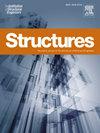考虑多种因素的中期和短期有效预应力损失:实验室和现场横梁实验
IF 3.9
2区 工程技术
Q1 ENGINEERING, CIVIL
引用次数: 0
摘要
混凝土的徐变和收缩、筋的松弛以及温度变化之间的耦合作用使得很难确定每个单独因素对预应力损失的影响。本研究探讨了这些多重因素对梁桥中期和短期预应力的影响,这对梁桥的耐久性和安全性至关重要。首先,在六座模型梁上进行了实验室实验,以分析中期和短期预应力变化。研究采用预先设计的方案,隔离并量化了对有效预应力的影响,并通过叠加计算了损失。研究结果与现有模型进行了比较,从而为影响预应力的多种因素提出了一个完善的模型。然后,根据提出的模型,通过回归分析,对十根全尺寸梁(有 35 根钢绞线)进行了预应力损失实验校准。根据修改后的预应力损失模型,可分别计算出上述影响因素,这与实验室和现场实验的测量数据相吻合。最后,研究得出结论,蠕变对预应力损失的影响最大,其他因素也有不同程度的影响。通过全尺寸试验,验证了预应力损失模型的参数。本研究提出的模型有效地描述了测试时间范围内的预应力损失。研究进一步得出结论,在实验室模型梁和现场全尺寸梁中,预应力筋和环境温度都存在时滞。建议在实际应用中进行有效预应力的提升试验时,在张拉后选择适当的试验时间,以获得相对稳定的结果。本文章由计算机程序翻译,如有差异,请以英文原文为准。
Medium and short-term effective prestress losses considering multiple factors: Laboratory and on-site beam experiments
The coupling between the creep and shrinkage of concrete, tendon relaxation, and temperature variations makes it difficult to determine the influence of each individual factor on prestress loss. This study investigates the influence of these multiple factors on the medium and short-term prestress of beam bridges, crucial for their durability and safety. Initially, laboratory experiments were conducted on six model beams to analyze medium and short-term prestress variations. Using a pre-designed scheme, the study isolated and quantified the impacts on effective prestress, with losses calculated through superposition. The findings were compared with existing models, leading to the proposal of a refined model for multiple factors affecting prestress. Then the prestress loss experiments on ten full-sized beams, with thirty-five strands, were calibrated based on the proposed model by regression analysis. Based on the modified model of prestress loss, the mentioned influencing factors would be calculated separately, which agree with the measured data from laboratory and in-situ experiments. In the end, the study concludes that creep has the greatest impact on prestress loss, with other factors contributing to varying degrees. Through full-scale tests, parameters for the prestress loss model were verified. The proposed model in this study effectively describes prestress loss within the tested timeframe. The study further concludes that there existed a time lag in prestress tendons and ambient temperature in both laboratory model beams and in-situ full-scale beams. For practical applications in lift-off tests of effective prestress, the appropriate testing time after tensioning to yield relatively stable results is recommended.
求助全文
通过发布文献求助,成功后即可免费获取论文全文。
去求助
来源期刊

Structures
Engineering-Architecture
CiteScore
5.70
自引率
17.10%
发文量
1187
期刊介绍:
Structures aims to publish internationally-leading research across the full breadth of structural engineering. Papers for Structures are particularly welcome in which high-quality research will benefit from wide readership of academics and practitioners such that not only high citation rates but also tangible industrial-related pathways to impact are achieved.
 求助内容:
求助内容: 应助结果提醒方式:
应助结果提醒方式:


